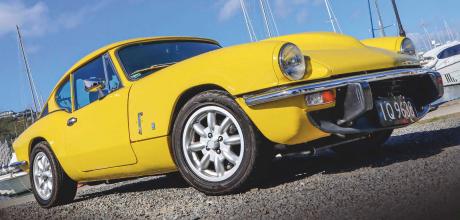1973 Triumph GT6
Vaughan discovers that there’s much more to this cute British sports car than meets the eye.
By Vaughan Wilson
Finally a wolf in wolfs clothing
TRIUMPH GT6MORE THAN MEETS THE EYE
The Americans have given us many culinary delights: the hot dog; the Reuben sandwich; the Big Mac; and, of course, that titanic of poultry delights, the ‘turducken’ – a chicken inside a duck inside a turkey – a white meat masterpiece.
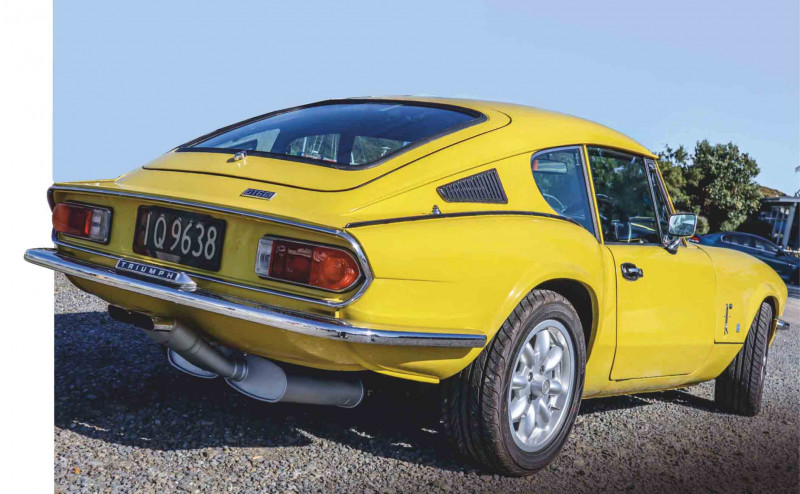
The original 1973 GT6 is a little like a turducken. First, take your original Triumph Spitfire, which was cute as a rabbit, then give it a wolf ’s clothing and stuff it with a meatier engine, but only slightly meatier, producing a sort of sheep in wolf ’s clothing. The result is your standard Triumph turducken: a sheep inside a rabbit that looks a bit like a wolf – sort of.
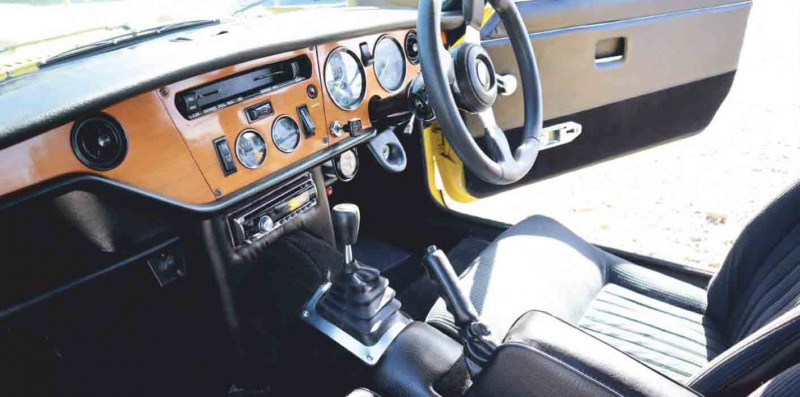
ITALIAN DESIGNED
If you don’t know a lot about the GT6, here is a morsel of history to chew on. The Triumph Spitfire was a sexy little convertible, typical of the small British soft-tops of the day. Lightweight and good looking, they sold in relatively good numbers against modest competition. Designed by the famed Italian auto designer Giovanni Michelotti in 1957, it was introduced at the London motor show in 1962. There were five production iterations of the car over 18 years, with just over 315,000 built utilising various drivetrains. Production ceased in 1980.
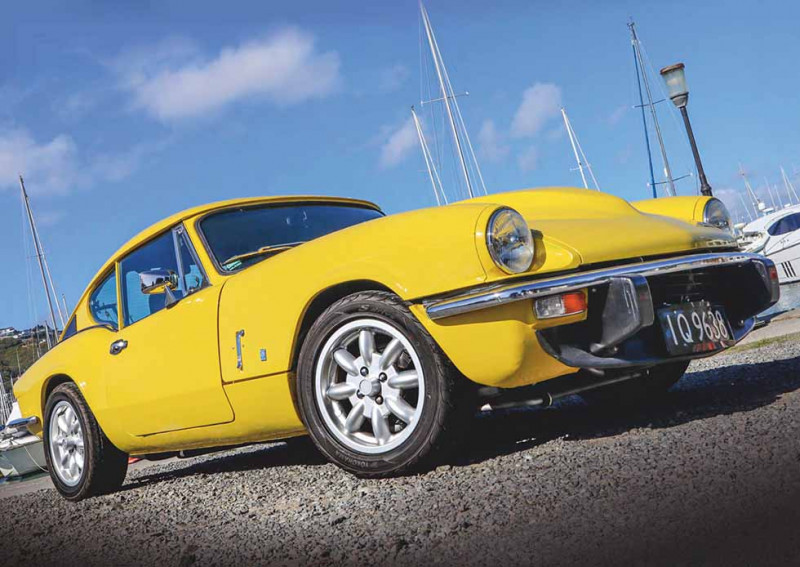
In 1963, Standard-Triumph, as the company was then known, delivered a Mk4 Spitfire to Michelotti’s studio in Italy and commissioned him to design a GT version. His design, delivered in physical form later that year, was a sleek fastback reminiscent of the E-Type fixed-head coup. launched in ’61. It was also not too dissimilar to the Mustang Fastback of 1964, a profile that would become familiar on other American models during the ’60s.
NOT SPITTING FIRE
Unfortunately, the engine used in the Spitfire at the time was a four-cylinder 1147cc unit rated at 63bhp (47kW). It was not up to the task of pushing the proposed GT down the road with any sort of liveliness due to the extra weight of the new body. The GT project was shelved.
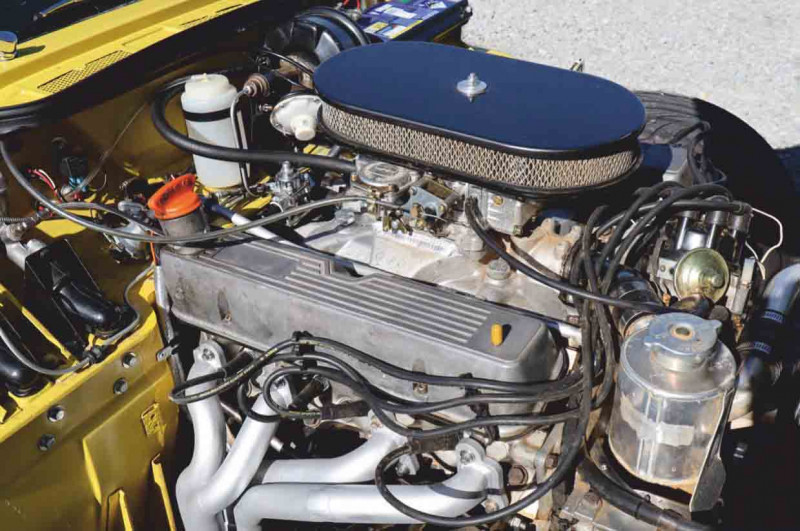
Then the Triumph racing programme rekindled the flame in 1964. The team chose to take a mould of the GT and graft a fibreglass body onto its Spitfire racing cars, thereby avoiding the weight but gaining the more streamlined shape of the GT. Successful racing in 1964 and 1965 saw Standard-Triumph reinvigorate the proposed model.
To overcome the weight for the roadgoing metal version, the larger 1996cc six-cylinder from the Triumph 2000 SC and Vitesse models was slotted. It was rated at 95bhp (71kW) and delivered a 0–100kph time of a hair under 12 seconds. The GT was launched in 1966 and stayed in production up until 1973.
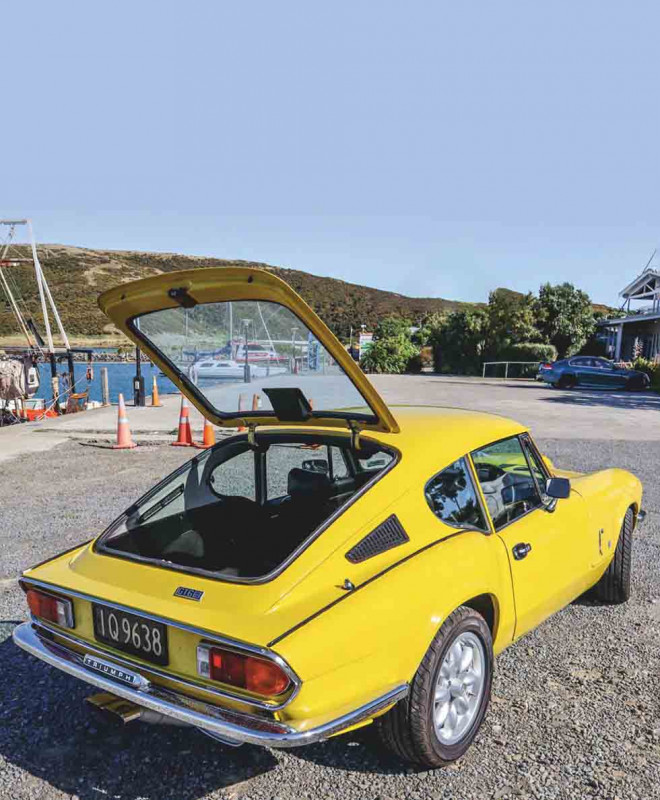
Eight years of production begat three model generations. Most of the changes were improvements to power, performance, and handling, helping the 0–100 times fall to around 10 seconds. The vehicle sold well, both in the UK and US, as well as in other markets where it was competing head-to-head with the MGB GT. Total production figures amounted to almost 41,000.
GARAGE PROJECT
John Burke of Paremata is a retired man of much energy and good humour. He served as the mayor of Porirua for six consecutive terms equating to 18 years. He now enjoys a more leisurely lifestyle with his wife and extended family. A firm lover of fine automobiles, John decided some years ago that he needed a project to keep him out from under his wife’s feet. An article in this magazine around 2018 on a beautiful little red GT6 whetted his appetite, and the search was on.
In 2019, John found a wonderful GT6 in Rangiora. It had been lovingly restored by an ex-Brit who had initially served an automotive mechanical apprenticeship in the UK in the late 1940s. The GT6 had been imported into New Zealand from the UK by a different owner in 1981. The Rangiora gentlemen had purchased it in 1993 and had refurbished it, including a body-off restoration. John flew to Rangiora, paid the money, and drove one day, beginning at 5am and finally arriving home just before midnight.
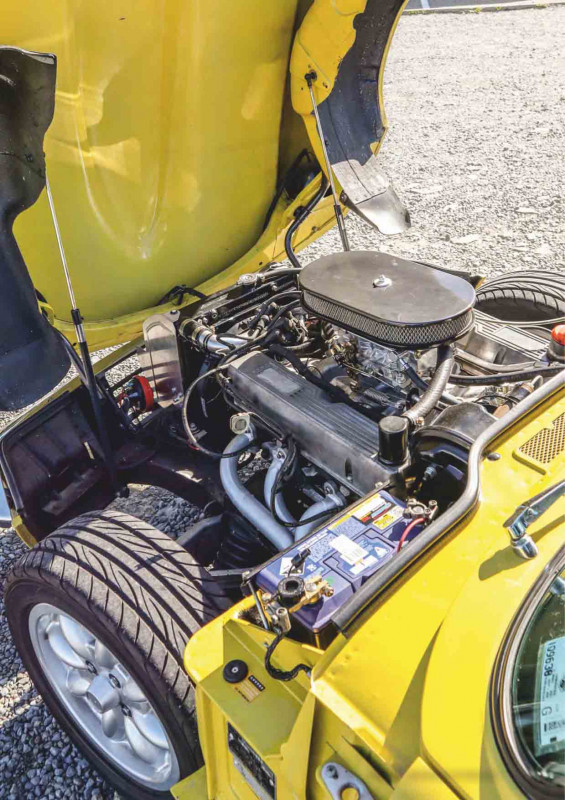
John had had thoughts of repowering a GT6 before he even purchased this car. He knew they were underpowered, particularly when compared with modern vehicles. He was also concerned that his better half, Linda, would, given the chance, drag him off at the lights in her mighty Mazda 2.
He tossed about the idea of the Triumph 2500TC engine, a popular upgrade in the 1970s, or a Rover 3.5 V8. The aluminium Rover V8 engine had started life as a Buick 215 (cubic inch), which was launched in 1960. It was light and powerful but expensive to manufacture compared with more usual Detroit iron. Rover approached Buick about purchasing the engine in early 1964, and by 1965 the deal was done.
GOOD BOY, ROVER
The engine stayed in mainstream production until 2004, appearing in a dazzling array of British vehicles before its last mainstream curtain call in the Range Rover Discovery. Its initial weight of 144kg and around 190– 200bhp (142–149kW) cemented it as a favourite power-plant for the more performance-oriented British vehicles of the time.
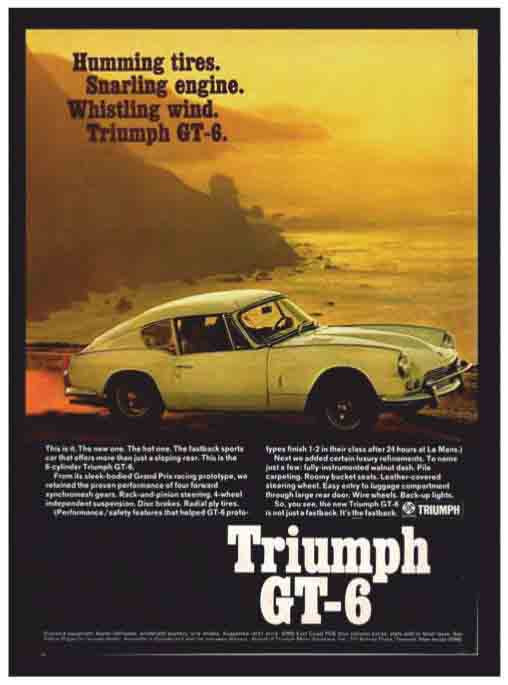
During its 37-year production in the UK, almost one million versions were produced for Rovers, TVRs, Morgans, Triumph TR8s, Range Rovers, Leyland P76s, and MGBs. Its production carried on in much more specialised form well after 2004.
Literally weighing up his options, John noted the Triumph 2500cc engine clocked in at around 33 per cent heavier than the V8, while offering half the power. An easy choice but one that wasn’t available at the time, so John bought a 2500 engine. He was just about to have the engine transplanted into the GT6 when an old Rover SD1 came up for sale, a Vitesse, no less, which had twin SU carbs. John purchased the Rover; had the engine removed; and the body, which was in good shape, was sold on to a Rover enthusiast.
Macbilt Engineering of Grenadain Wellington was trusted with the work and the team set about transplanting the V8 into the GT6. The result had a lower kerb weight than even the old two-litre six-cylinder.
Triumph joined Leyland in 1967 and Rover followed suit in 1971. The various marques had to compete for funds for their various model developments in the cash-strapped corporation, the British Government soon having to step in and bail the flailing corporation out in 1974.
SQUARING THE CIRCLE
Another beautiful Triumph of the time was the Stag, which was released in 1970 and stayed in production until 1977. It had very little competition and was expected to sell well, but its three-litre V8 had not been properly developed before being rushed into production and it suffered numerous problems. With a lack of cash in the till, the model was quietly dropped.
It has long been said that the Stag would have been much more successfulif internal jealousies had been put aside and it had been equipped with the Rover V8. The Rover mill put out a similar power at a similar weight but already had 10 years of development behind it, much of this in the US with Buick.
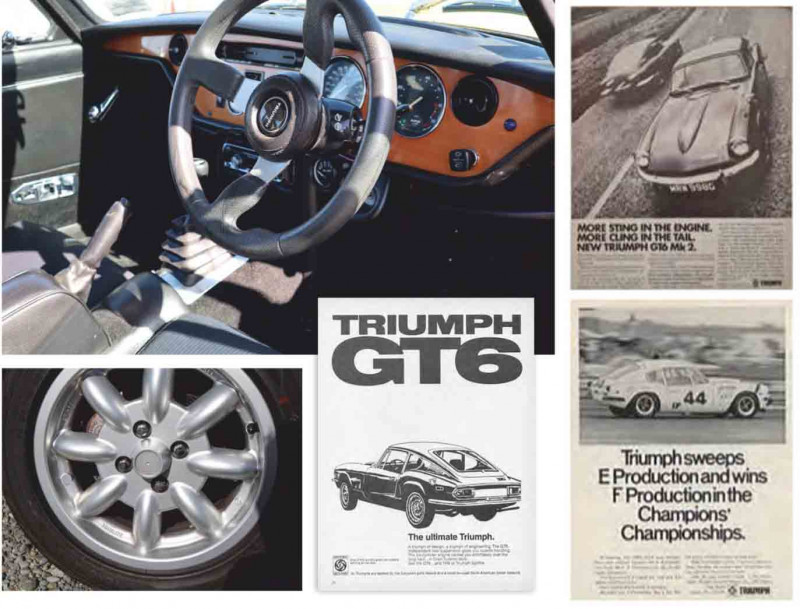
The Stag was also designed by Michelotti, and his beautiful lines and curves also shine through on the Spitfire and the GT6. It is therefore appropriate that John’s GT6 adopted the engine that should have powered its larger brother. John had Macbilt install the Dutch EZ electric power-steering unit, which also gives the car a more modern feel and a more enjoyable drive. Although still heavy, it is better than no assistance as per factory standard.
The factory wheels were a 13-inch design that John swapped for 14-inch Minilites. They give the car a more sporty appearance without losing the classic looks. The colour is Mimosa Yellow, a factory colour. It is what this GT6 was first sold in, and the paintwork shown was carried out as part of the renovation in Rangiora. A four-barrel Holley carb was added, increasing the engine’s power but also its height, accommodated by a larger hump in the middle of the bonnet. The new engine sits well back, and there is plenty of room under the bonnet, which allowed Macbilt to install a modified manifold, fan, and new radiator.
The car has not been on a dyno, but John suspects its numbers would sit around 210–225bhp (157–168kW). It now has a Toyota five-speed manual gearbox replacing the original four-speed. The differential is the original unit, as are the brakes, withdiscs at the front and drums on the rear. The car was completed and delivered in December 2022. John is very happy with his pet project, the restomod of his imagination. His one intended change is to install a larger radiator to help improve the cooling.
UNLEASHING THE BEAST
I have never been in a GT6, much less driven one, but John encourages me to take the wheel. You don’t sit in one of these cars so much as climb down into it. Tall people are not friends of the GT6, neither are those who find yoga exercises challenging. Ensuring that one’s legs are sitting alongside the transmission tunnel with the right feet over the right pedals takes a little focus.
Pulling away, the exhaust emits a lovely V8 burble, and there is more than enough power to get the heart racing without breaking the sound barrier. To get to the photo shoot location, we have to cross over a number of speed humps and train lines, and the GT6 does this with ease and no scraping.
The yellow colour and pretty shape of the Triumph attract admiring stares. You don’t see too many GT6s these days, and their values are climbing. John is quick to point out that the original drivetrain meant they were hard going to drive long distances – as he found out, on his first day of ownership, from Rangiora to Picton.
A big thank you to John for sharing his new passion. The GT6 is now in an easy-to-use form that he can enjoy for many years and eventually pass down to his family.
John is very happy with his pet project, the restomod of his imagination
The sports steering wheel connects to a Dutch EZ electric power-steering unit. Fourteen-inch Minilites – the perfect choice. This sleek fastback is reminiscent of the E-Type fixed-head coupé launched in ’61.
The 3.5-litre V8 provides more than enough power to get the heart racing
The colour is Mimosa Yellow, a factory colour. It is what this GT6 was first sold in, and the paintwork shown was carried out as part of the renovation in Rangiora
Beautiful lines and curves shine through on the GT6
He tossed about the idea of the Triumph 2500TC engine, a popular upgrade in the 1970s, or a Rover 3.5 V8
A firm lover of fine automobiles, John decided some years ago that he needed a project to keep him out from under his wife’s feet
TECHNICAL DATA 1973 TRIUMPH GT6
- Engine (as featured) Rover V8
- Capacity 3.5-litre (originally 1147cc)
- Bore/Stroke 88.9mm/71.7mm
- Comp. ratio 9.35:1
- Valves 16
- Fuel system Four-barrel Holley carburettor
- Max. power 120kW at 5250rpm
- Max. torque 268Nm at 2500rpm
- Gearbox Toyota five-speed manual
- Brakes, F/R Disc/Drum
Dimensions:
- Length 4698mm
- Wheelbase 2815mm
- Width 1768mm
- Height 1385mm
- Weight NA
The 3.5-litre Rover V8 was chosen over the more popular Triumph 2500TC upgrade
It was also not too dissimilar to the Mustang Fastback of 1964, a profile that would become familiar on other American models during the ’60s


